-
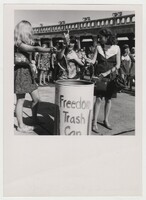 Freedom Trash Can, Miss America protest, Atlantic City, 1968
Freedom Trash Can, Miss America protest, Atlantic City, 1968 Two women at the Miss America protest in Atlantic City, throw items into the "freedom trashcan" which symbolized freeing themselves from the "feminine" label and role given to them by society. As they throw their items, a female reporter watches and records audio through a handheld microphone. In the background, many other women standby in the protest, one of them wearing her bra on top of her dress as a symbol of liberation.
-
 Alfredo Gutierrez on the Equal Rights Amendment
Alfredo Gutierrez on the Equal Rights Amendment This is a 3 minute interview conducted by Carol Palmer with Alfredo Gutierrez a past senator of Arizona, recalling his interaction with the ERA in the early 70's through the 80's. He mentions how the bill seemed to fail by just one vote more often than not, he himself supporting the bill, explains how he just did not understand the opposition to it and the horror that many of his counterparts were sure would play out if the bill passed.
-
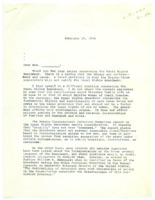 Form letter from Senator Sandra Day O'Connor, February 18, 1974, re: Equal Rights Amendment
Form letter from Senator Sandra Day O'Connor, February 18, 1974, re: Equal Rights Amendment In this typed letter by Sandra Day O'Connor, she responds to an inquiry on the Equal Rights Amendment ratification by saying she does not believe it will be ratified by the coming vote, despite her support. She explains that there are misconceptions regarding the ERA and what it aims to do, seeing as some believe it is stripping women's rights but in reality it is just providing legal and governmental equality between genders. She expresses that the ERA should be discussed more openly with Arizona citizens in order to educate as well as take a vote on it.
-
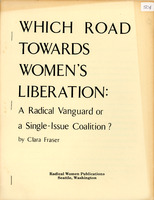 Which Road Towards Women's Liberation
Which Road Towards Women's Liberation A copy of the mini zine by Clara Fraser in which she discusses the structure of feminism in regards to the issues it faces, thus making it multidimensional and acknowledging that, to be successful it needs to support all groups of women through intersectional feminism. In the midst of the second wave of feminism, there were numerous agendas being pushed by different groups of women and feminist supporters. These differences led to division amongst the groups and an idea that there were internal issues and biases in the feminist movement. The idea of intersectional feminism promotes the inclusion of all groups and agendas under the feminism as the umbrella term/movement.
-
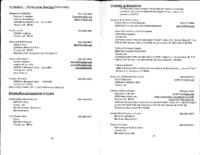 Southern Arizona Gender Alliance Resource and Service Guides
Southern Arizona Gender Alliance Resource and Service Guides A compiled, printed list of resources and establishments in Tucson that offer their support and services to individuals who identify as transgendered. The list includes legal help, churches, stores, lodging and travel resources, alphabetized for ease of reading. Within each service listing is the title of the establishment as well as the address and their phone number. Below the establishments is a collection of online resources as well, followed by a personal notes page.
-
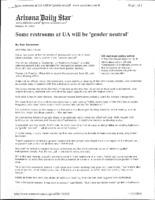 Arizona Daily Star 2006 Article - U of A Gender Neutral Bathroom
Arizona Daily Star 2006 Article - U of A Gender Neutral Bathroom A brief article discussing the introduction of gender neutral bathrooms to the University of Arizona in order to help accommodate all genders and individuals on campus. Within the article is a short Q&A from Jessica Pettitt about her experiences in the current bathrooms as a an androgynous woman and how negatively she is received until other women notice her figure and say she is "okay" in the bathroom with them.
-
 Southwest Feminists Reunite ~ “40th Anniversary Event” • 2nd Wave 5th Avenue Women's Collective: Interview with Lavina Tomer, Lydia Breen, Ellen Litman, Linda Hellman, and Doris Dillon
Southwest Feminists Reunite ~ “40th Anniversary Event” • 2nd Wave 5th Avenue Women's Collective: Interview with Lavina Tomer, Lydia Breen, Ellen Litman, Linda Hellman, and Doris Dillon A collective oral history interview between 5 members of the Southwest Feminists Reunite retreat group. They recount and discuss their experiences at the retreat in 1973, and how those experiences helped shape the next 40 years for women across the Southwest in the fight for their equality. The interview was conducted by Jamie A. Lee and produced by Anastasia Freyermuth.
-
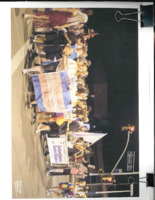 2016 Southern Arizona Gender Alliance Contingent to Tucson Pride Parade Photograph
2016 Southern Arizona Gender Alliance Contingent to Tucson Pride Parade Photograph A printed photograph of members in the Southern Arizona Gender Alliance walking in the Tucson Pride march. At the front of the group, are the younger members holding both the SAGA flag as well as the transgender flag with the goal to unite all genders.
-
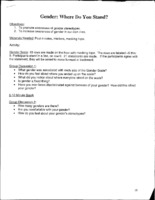 Trans 101 Gender Stereotypes Activity
Trans 101 Gender Stereotypes Activity A printed lesson plan from 2006, focusing on discussing gender stereotypes by prompting questions to participants in the form of "take one step forward if...". The activity was sponsored by the Southern Arizona Gender Alliance with aims to help break gender stereotypes and support diversity between all genders. The event took place on November 14th, 2006, between 10:30-11:30am.
-
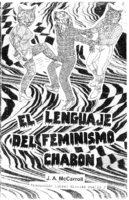 El Lenguaje del Feminismo Chabon
El Lenguaje del Feminismo Chabon An illustrated magazine cover written in Spanish that aims to describe the views of feminism from a heterosexual male perspective. The cover shows the idea that some men feel as though the liberation of women means the emasculation of men, hence the image of the two cats (the women) fighting the dog (the man). The title translates to "the language of feminism".
-
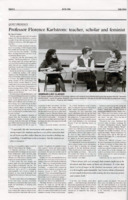 The Pine, June 1990
The Pine, June 1990 This is a 1990 NAU newspaper article that focuses on Professor Florence Karlstrom and her experiences/views as a female professor in sociology. In the article, it highlights what she views feminism as in terms of an operational definition. To Dr. Karlstrom, feminism is about the equality of both genders alike and the shared empowerment.
-
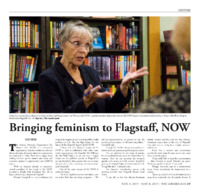 The Lumberjack, November 2, 2017
The Lumberjack, November 2, 2017 Page 17 of the NAU school newspaper, which discusses the hopeful introduction of a new Flagstaff chapter for Arizona National Organization for Women (AzNOW).
-
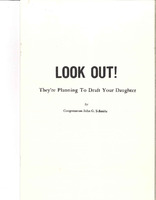 "Look Out! They're Planning to Draft Your Daughter" pamphlet
"Look Out! They're Planning to Draft Your Daughter" pamphlet A pamphlet opposing the ratification of the Equal Rights Amendment. In the pamphlet, Congressman Schmitz, focuses on the possibility of the bill sending women into the draft as equally as men. This fear of female drafting appeared to be the biggest factor people claimed opposition for at the time. He aims to expose the underlying "radical" motives that lie beneath the sections of the ERA.
-
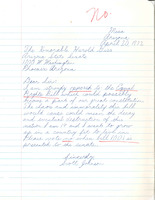 Letters from Mesa school children about the ERA
Letters from Mesa school children about the ERA A collection of letters sent by schoolchildren of Mesa, Arizona, urging Senator Harold Giss to vote against the Equal Rights Amendment. These children, both boys and girls, were middle school aged at the time and expressed their concerns about the roles women would play in society should the bill be passed. They focus a lot on the fear of women being drafted, leaving children across the country, homeless and belonging to the system.
-
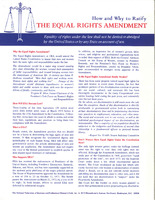 Pamphlet on the Equal Rights Amendment
Pamphlet on the Equal Rights Amendment An informational pamphlet from The National Federation of Business and Professional Women's Club (NFBPWC) in support of ratifying the Equal Rights Amendment. The pamphlet briefly explains what the amendment is and uses supporting testimonies to discuss the areas in which women will be affected and why it is important for such change.
-
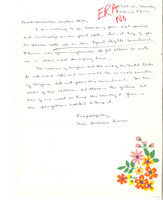 Personal note from Barbara Roever to Harold Giss about the ERA
Personal note from Barbara Roever to Harold Giss about the ERA This is a personal, handwritten statement from Mrs. Roever, urging Senator Harold Giss to vote against the Equal Rights Amendment because it will destroy the free nature of the country and will have devastating impacts on future generations.
-
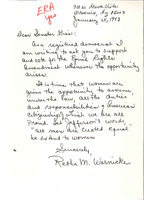 Personal note from R. Warnicke to Harold Giss about the ERA.
Personal note from R. Warnicke to Harold Giss about the ERA. This is a handwritten letter addressed to Senator Harold Giss in which Retha Warnicke expresses her support for the ERA. She believes it is time that the idea of men being created equal is extended to include women. She hopes Senator Giss will feel the same and vote yes on the ERA.
-
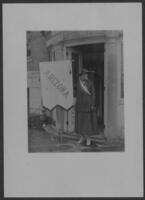 Mrs. Weller of Arizona
Mrs. Weller of Arizona A black and white photograph of Mrs. Weller, an Arizona suffragette, standing outside in the rain while wearing a suffrage sash and holding a banner for the Arizona state parade. She stands in front of a building door next to her banner that says "Arizona" diagonally.
-
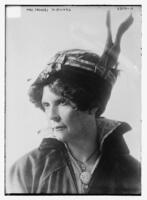 Mrs. Frances W. Munds
Mrs. Frances W. Munds A portrait photograph of Francis Mund, an Arizona state senator of the early 1900s. She contributed to the ratification of the 19th Amendment for women’s voting rights in 1912. The photo is a black and white portrait of her as she looks towards the left. In the photo she is wearing a headband with a bow on the front as well as one on the right side which tails point upward.
-
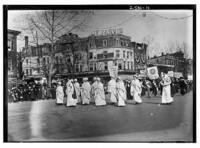 Suffrage Parade
Suffrage Parade A black and white photograph showing a collection of women marching for women’s suffrage in the streets of Washington D.C.. There are 11 women dressed in their suffragette uniform of a white dress adorned with gold, purple or green sashes. They are also carrying a National Women's Suffrage banner. Within the forefront group of women is Mrs. Weller, the suffragette representative for the state of Arizona. Along the sides of the streets is an audience or crowd made up of men, women and children.
-
 Southwest Feminists Reunite- Corrie Furst Interview
Southwest Feminists Reunite- Corrie Furst Interview This is an oral history interview with self identified feminist, Corrie First regarding her experiences with the Southwest Feminists Unite group which was founded in the 70's. This interview is part of the Southwest Feminists Reunite collection to celebrate their 40th anniversary and remember not only their personal experiences within the SWFU group, but also the spark that the group ignited for the feminism and gender equality movement specifically in Tucson, Arizona.
 Freedom Trash Can, Miss America protest, Atlantic City, 1968 Two women at the Miss America protest in Atlantic City, throw items into the "freedom trashcan" which symbolized freeing themselves from the "feminine" label and role given to them by society. As they throw their items, a female reporter watches and records audio through a handheld microphone. In the background, many other women standby in the protest, one of them wearing her bra on top of her dress as a symbol of liberation.
Freedom Trash Can, Miss America protest, Atlantic City, 1968 Two women at the Miss America protest in Atlantic City, throw items into the "freedom trashcan" which symbolized freeing themselves from the "feminine" label and role given to them by society. As they throw their items, a female reporter watches and records audio through a handheld microphone. In the background, many other women standby in the protest, one of them wearing her bra on top of her dress as a symbol of liberation. Alfredo Gutierrez on the Equal Rights Amendment This is a 3 minute interview conducted by Carol Palmer with Alfredo Gutierrez a past senator of Arizona, recalling his interaction with the ERA in the early 70's through the 80's. He mentions how the bill seemed to fail by just one vote more often than not, he himself supporting the bill, explains how he just did not understand the opposition to it and the horror that many of his counterparts were sure would play out if the bill passed.
Alfredo Gutierrez on the Equal Rights Amendment This is a 3 minute interview conducted by Carol Palmer with Alfredo Gutierrez a past senator of Arizona, recalling his interaction with the ERA in the early 70's through the 80's. He mentions how the bill seemed to fail by just one vote more often than not, he himself supporting the bill, explains how he just did not understand the opposition to it and the horror that many of his counterparts were sure would play out if the bill passed. Form letter from Senator Sandra Day O'Connor, February 18, 1974, re: Equal Rights Amendment In this typed letter by Sandra Day O'Connor, she responds to an inquiry on the Equal Rights Amendment ratification by saying she does not believe it will be ratified by the coming vote, despite her support. She explains that there are misconceptions regarding the ERA and what it aims to do, seeing as some believe it is stripping women's rights but in reality it is just providing legal and governmental equality between genders. She expresses that the ERA should be discussed more openly with Arizona citizens in order to educate as well as take a vote on it.
Form letter from Senator Sandra Day O'Connor, February 18, 1974, re: Equal Rights Amendment In this typed letter by Sandra Day O'Connor, she responds to an inquiry on the Equal Rights Amendment ratification by saying she does not believe it will be ratified by the coming vote, despite her support. She explains that there are misconceptions regarding the ERA and what it aims to do, seeing as some believe it is stripping women's rights but in reality it is just providing legal and governmental equality between genders. She expresses that the ERA should be discussed more openly with Arizona citizens in order to educate as well as take a vote on it. Which Road Towards Women's Liberation A copy of the mini zine by Clara Fraser in which she discusses the structure of feminism in regards to the issues it faces, thus making it multidimensional and acknowledging that, to be successful it needs to support all groups of women through intersectional feminism. In the midst of the second wave of feminism, there were numerous agendas being pushed by different groups of women and feminist supporters. These differences led to division amongst the groups and an idea that there were internal issues and biases in the feminist movement. The idea of intersectional feminism promotes the inclusion of all groups and agendas under the feminism as the umbrella term/movement.
Which Road Towards Women's Liberation A copy of the mini zine by Clara Fraser in which she discusses the structure of feminism in regards to the issues it faces, thus making it multidimensional and acknowledging that, to be successful it needs to support all groups of women through intersectional feminism. In the midst of the second wave of feminism, there were numerous agendas being pushed by different groups of women and feminist supporters. These differences led to division amongst the groups and an idea that there were internal issues and biases in the feminist movement. The idea of intersectional feminism promotes the inclusion of all groups and agendas under the feminism as the umbrella term/movement. Southern Arizona Gender Alliance Resource and Service Guides A compiled, printed list of resources and establishments in Tucson that offer their support and services to individuals who identify as transgendered. The list includes legal help, churches, stores, lodging and travel resources, alphabetized for ease of reading. Within each service listing is the title of the establishment as well as the address and their phone number. Below the establishments is a collection of online resources as well, followed by a personal notes page.
Southern Arizona Gender Alliance Resource and Service Guides A compiled, printed list of resources and establishments in Tucson that offer their support and services to individuals who identify as transgendered. The list includes legal help, churches, stores, lodging and travel resources, alphabetized for ease of reading. Within each service listing is the title of the establishment as well as the address and their phone number. Below the establishments is a collection of online resources as well, followed by a personal notes page. Arizona Daily Star 2006 Article - U of A Gender Neutral Bathroom A brief article discussing the introduction of gender neutral bathrooms to the University of Arizona in order to help accommodate all genders and individuals on campus. Within the article is a short Q&A from Jessica Pettitt about her experiences in the current bathrooms as a an androgynous woman and how negatively she is received until other women notice her figure and say she is "okay" in the bathroom with them.
Arizona Daily Star 2006 Article - U of A Gender Neutral Bathroom A brief article discussing the introduction of gender neutral bathrooms to the University of Arizona in order to help accommodate all genders and individuals on campus. Within the article is a short Q&A from Jessica Pettitt about her experiences in the current bathrooms as a an androgynous woman and how negatively she is received until other women notice her figure and say she is "okay" in the bathroom with them. Southwest Feminists Reunite ~ “40th Anniversary Event” • 2nd Wave 5th Avenue Women's Collective: Interview with Lavina Tomer, Lydia Breen, Ellen Litman, Linda Hellman, and Doris Dillon A collective oral history interview between 5 members of the Southwest Feminists Reunite retreat group. They recount and discuss their experiences at the retreat in 1973, and how those experiences helped shape the next 40 years for women across the Southwest in the fight for their equality. The interview was conducted by Jamie A. Lee and produced by Anastasia Freyermuth.
Southwest Feminists Reunite ~ “40th Anniversary Event” • 2nd Wave 5th Avenue Women's Collective: Interview with Lavina Tomer, Lydia Breen, Ellen Litman, Linda Hellman, and Doris Dillon A collective oral history interview between 5 members of the Southwest Feminists Reunite retreat group. They recount and discuss their experiences at the retreat in 1973, and how those experiences helped shape the next 40 years for women across the Southwest in the fight for their equality. The interview was conducted by Jamie A. Lee and produced by Anastasia Freyermuth. 2016 Southern Arizona Gender Alliance Contingent to Tucson Pride Parade Photograph A printed photograph of members in the Southern Arizona Gender Alliance walking in the Tucson Pride march. At the front of the group, are the younger members holding both the SAGA flag as well as the transgender flag with the goal to unite all genders.
2016 Southern Arizona Gender Alliance Contingent to Tucson Pride Parade Photograph A printed photograph of members in the Southern Arizona Gender Alliance walking in the Tucson Pride march. At the front of the group, are the younger members holding both the SAGA flag as well as the transgender flag with the goal to unite all genders. Trans 101 Gender Stereotypes Activity A printed lesson plan from 2006, focusing on discussing gender stereotypes by prompting questions to participants in the form of "take one step forward if...". The activity was sponsored by the Southern Arizona Gender Alliance with aims to help break gender stereotypes and support diversity between all genders. The event took place on November 14th, 2006, between 10:30-11:30am.
Trans 101 Gender Stereotypes Activity A printed lesson plan from 2006, focusing on discussing gender stereotypes by prompting questions to participants in the form of "take one step forward if...". The activity was sponsored by the Southern Arizona Gender Alliance with aims to help break gender stereotypes and support diversity between all genders. The event took place on November 14th, 2006, between 10:30-11:30am. El Lenguaje del Feminismo Chabon An illustrated magazine cover written in Spanish that aims to describe the views of feminism from a heterosexual male perspective. The cover shows the idea that some men feel as though the liberation of women means the emasculation of men, hence the image of the two cats (the women) fighting the dog (the man). The title translates to "the language of feminism".
El Lenguaje del Feminismo Chabon An illustrated magazine cover written in Spanish that aims to describe the views of feminism from a heterosexual male perspective. The cover shows the idea that some men feel as though the liberation of women means the emasculation of men, hence the image of the two cats (the women) fighting the dog (the man). The title translates to "the language of feminism". The Pine, June 1990 This is a 1990 NAU newspaper article that focuses on Professor Florence Karlstrom and her experiences/views as a female professor in sociology. In the article, it highlights what she views feminism as in terms of an operational definition. To Dr. Karlstrom, feminism is about the equality of both genders alike and the shared empowerment.
The Pine, June 1990 This is a 1990 NAU newspaper article that focuses on Professor Florence Karlstrom and her experiences/views as a female professor in sociology. In the article, it highlights what she views feminism as in terms of an operational definition. To Dr. Karlstrom, feminism is about the equality of both genders alike and the shared empowerment. The Lumberjack, November 2, 2017 Page 17 of the NAU school newspaper, which discusses the hopeful introduction of a new Flagstaff chapter for Arizona National Organization for Women (AzNOW).
The Lumberjack, November 2, 2017 Page 17 of the NAU school newspaper, which discusses the hopeful introduction of a new Flagstaff chapter for Arizona National Organization for Women (AzNOW). "Look Out! They're Planning to Draft Your Daughter" pamphlet A pamphlet opposing the ratification of the Equal Rights Amendment. In the pamphlet, Congressman Schmitz, focuses on the possibility of the bill sending women into the draft as equally as men. This fear of female drafting appeared to be the biggest factor people claimed opposition for at the time. He aims to expose the underlying "radical" motives that lie beneath the sections of the ERA.
"Look Out! They're Planning to Draft Your Daughter" pamphlet A pamphlet opposing the ratification of the Equal Rights Amendment. In the pamphlet, Congressman Schmitz, focuses on the possibility of the bill sending women into the draft as equally as men. This fear of female drafting appeared to be the biggest factor people claimed opposition for at the time. He aims to expose the underlying "radical" motives that lie beneath the sections of the ERA. Letters from Mesa school children about the ERA A collection of letters sent by schoolchildren of Mesa, Arizona, urging Senator Harold Giss to vote against the Equal Rights Amendment. These children, both boys and girls, were middle school aged at the time and expressed their concerns about the roles women would play in society should the bill be passed. They focus a lot on the fear of women being drafted, leaving children across the country, homeless and belonging to the system.
Letters from Mesa school children about the ERA A collection of letters sent by schoolchildren of Mesa, Arizona, urging Senator Harold Giss to vote against the Equal Rights Amendment. These children, both boys and girls, were middle school aged at the time and expressed their concerns about the roles women would play in society should the bill be passed. They focus a lot on the fear of women being drafted, leaving children across the country, homeless and belonging to the system. Pamphlet on the Equal Rights Amendment An informational pamphlet from The National Federation of Business and Professional Women's Club (NFBPWC) in support of ratifying the Equal Rights Amendment. The pamphlet briefly explains what the amendment is and uses supporting testimonies to discuss the areas in which women will be affected and why it is important for such change.
Pamphlet on the Equal Rights Amendment An informational pamphlet from The National Federation of Business and Professional Women's Club (NFBPWC) in support of ratifying the Equal Rights Amendment. The pamphlet briefly explains what the amendment is and uses supporting testimonies to discuss the areas in which women will be affected and why it is important for such change. Personal note from Barbara Roever to Harold Giss about the ERA This is a personal, handwritten statement from Mrs. Roever, urging Senator Harold Giss to vote against the Equal Rights Amendment because it will destroy the free nature of the country and will have devastating impacts on future generations.
Personal note from Barbara Roever to Harold Giss about the ERA This is a personal, handwritten statement from Mrs. Roever, urging Senator Harold Giss to vote against the Equal Rights Amendment because it will destroy the free nature of the country and will have devastating impacts on future generations. Personal note from R. Warnicke to Harold Giss about the ERA. This is a handwritten letter addressed to Senator Harold Giss in which Retha Warnicke expresses her support for the ERA. She believes it is time that the idea of men being created equal is extended to include women. She hopes Senator Giss will feel the same and vote yes on the ERA.
Personal note from R. Warnicke to Harold Giss about the ERA. This is a handwritten letter addressed to Senator Harold Giss in which Retha Warnicke expresses her support for the ERA. She believes it is time that the idea of men being created equal is extended to include women. She hopes Senator Giss will feel the same and vote yes on the ERA. Mrs. Weller of Arizona A black and white photograph of Mrs. Weller, an Arizona suffragette, standing outside in the rain while wearing a suffrage sash and holding a banner for the Arizona state parade. She stands in front of a building door next to her banner that says "Arizona" diagonally.
Mrs. Weller of Arizona A black and white photograph of Mrs. Weller, an Arizona suffragette, standing outside in the rain while wearing a suffrage sash and holding a banner for the Arizona state parade. She stands in front of a building door next to her banner that says "Arizona" diagonally. Mrs. Frances W. Munds A portrait photograph of Francis Mund, an Arizona state senator of the early 1900s. She contributed to the ratification of the 19th Amendment for women’s voting rights in 1912. The photo is a black and white portrait of her as she looks towards the left. In the photo she is wearing a headband with a bow on the front as well as one on the right side which tails point upward.
Mrs. Frances W. Munds A portrait photograph of Francis Mund, an Arizona state senator of the early 1900s. She contributed to the ratification of the 19th Amendment for women’s voting rights in 1912. The photo is a black and white portrait of her as she looks towards the left. In the photo she is wearing a headband with a bow on the front as well as one on the right side which tails point upward. Suffrage Parade A black and white photograph showing a collection of women marching for women’s suffrage in the streets of Washington D.C.. There are 11 women dressed in their suffragette uniform of a white dress adorned with gold, purple or green sashes. They are also carrying a National Women's Suffrage banner. Within the forefront group of women is Mrs. Weller, the suffragette representative for the state of Arizona. Along the sides of the streets is an audience or crowd made up of men, women and children.
Suffrage Parade A black and white photograph showing a collection of women marching for women’s suffrage in the streets of Washington D.C.. There are 11 women dressed in their suffragette uniform of a white dress adorned with gold, purple or green sashes. They are also carrying a National Women's Suffrage banner. Within the forefront group of women is Mrs. Weller, the suffragette representative for the state of Arizona. Along the sides of the streets is an audience or crowd made up of men, women and children. Southwest Feminists Reunite- Corrie Furst Interview This is an oral history interview with self identified feminist, Corrie First regarding her experiences with the Southwest Feminists Unite group which was founded in the 70's. This interview is part of the Southwest Feminists Reunite collection to celebrate their 40th anniversary and remember not only their personal experiences within the SWFU group, but also the spark that the group ignited for the feminism and gender equality movement specifically in Tucson, Arizona.
Southwest Feminists Reunite- Corrie Furst Interview This is an oral history interview with self identified feminist, Corrie First regarding her experiences with the Southwest Feminists Unite group which was founded in the 70's. This interview is part of the Southwest Feminists Reunite collection to celebrate their 40th anniversary and remember not only their personal experiences within the SWFU group, but also the spark that the group ignited for the feminism and gender equality movement specifically in Tucson, Arizona.